Rice pilaf is a tasty rice dish loved worldwide. It’s made by cooking rice in a flavorful broth with aromatic ingredients. These ingredients add depth and complexity to the dish.
The main ingredient is long-grain white rice. It cooks up light and fluffy, with distinct grains. Before adding liquid, the rice is sautéed in oil or butter. This step toasts the grains and infuses them with flavor.
Rice pilaf also includes onions, garlic, and spices. These add a rich, savory base to the dish. Sometimes, vegetables, meats, or dried fruits are added to enhance flavor and texture.
The cooking method is key to this meal. It’s simmered in a flavorful broth, not just boiled in water. This method infuses the rice with a deeper flavor. The rice to liquid ratio is important, usually 1:2.
This meal is versatile and delicious, fitting many tastes and diets. By knowing the ingredients and cooking methods, you can make a pilaf that suits your taste. Enjoy the rich, satisfying flavors of this beloved dish.
Understanding Rice Pilaf
Rice pilaf is a dish loved by many around the world. It’s not just rice; it’s a cooking method that has been loved for centuries. From Central Asia to the Middle East and India, it’s a favorite in many homes.
Definition of Rice Pilaf
Rice pilaf is made by sautéing rice in oil or butter with onions, garlic, and spices. Then, it’s simmered in a tasty broth until it’s fluffy. This way, the rice keeps its unique taste and texture.
Origin and History of Pilaf
Pilaf comes from ancient Central Asia, like Uzbekistan and Kazakhstan. It’s a beloved dish there. Over time, it spread to the Middle East and India, where it got new flavors.
In the Middle East, pilaf often includes chicken, lamb, and nuts. In India, it’s called “pulao” and is made with basmati rice, vegetables, and spices.
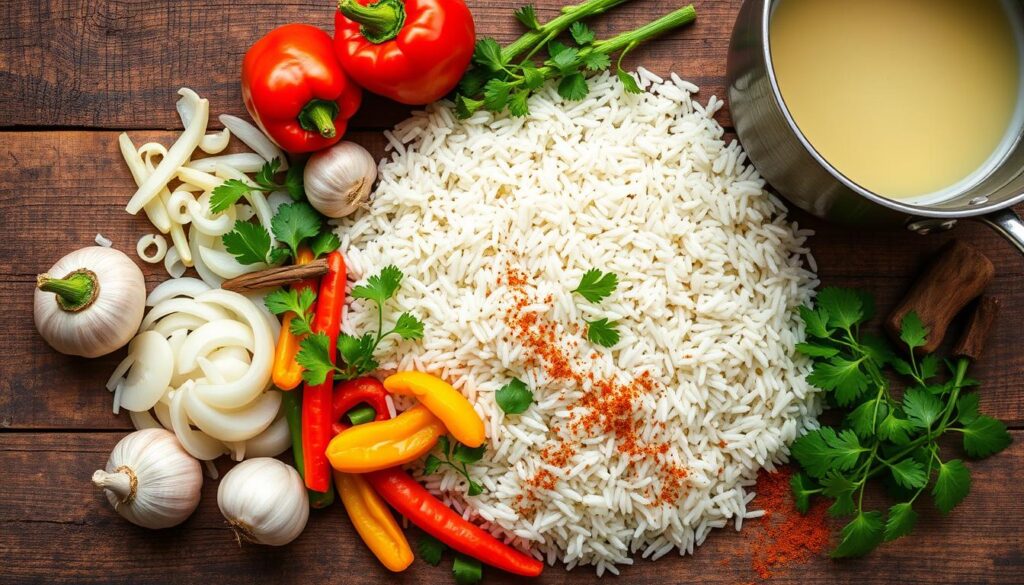
Pilaf is loved everywhere because it can be made in so many ways. It uses different types of rice and spices, making it a global favorite.
Key Ingredients in Rice Pilaf
Creating the perfect rice pilaf starts with the right ingredients. The type of rice, aromatic elements, and liquids all matter. Each one adds to the flavor and texture of this classic dish. Let’s explore the main ingredients that make this meal stand out.
Types of Rice Suitable for Pilaf
Long-grain white rice, like basmati, is the top pick for this meal. It’s fluffy and light. Recipes often use 1 1/2 cups of basmati rice for 6-8 people. Brown rice is another option, but it cooks longer and needs more liquid.
Common Aromatics Used
Aromatics are key to a tasty rice pilaf. Onions and garlic are staples, with onions caramelized for 12-15 minutes. This makes them sweet and flavorful. Other veggies like celery, carrots, or leeks can also be added for more depth.
Broths and Liquids in Pilaf
The liquid is vital in this recipes. Chicken or vegetable broth is usually the choice, adding savory flavor. Some recipes mix broth and water, or even add orzo pasta for texture.
Ingredients like olive oil or butter, salt, and pepper are also important. They season the dish. Making this classic meal takes about 55 minutes, with 10 minutes of prep and 45 minutes of cooking.
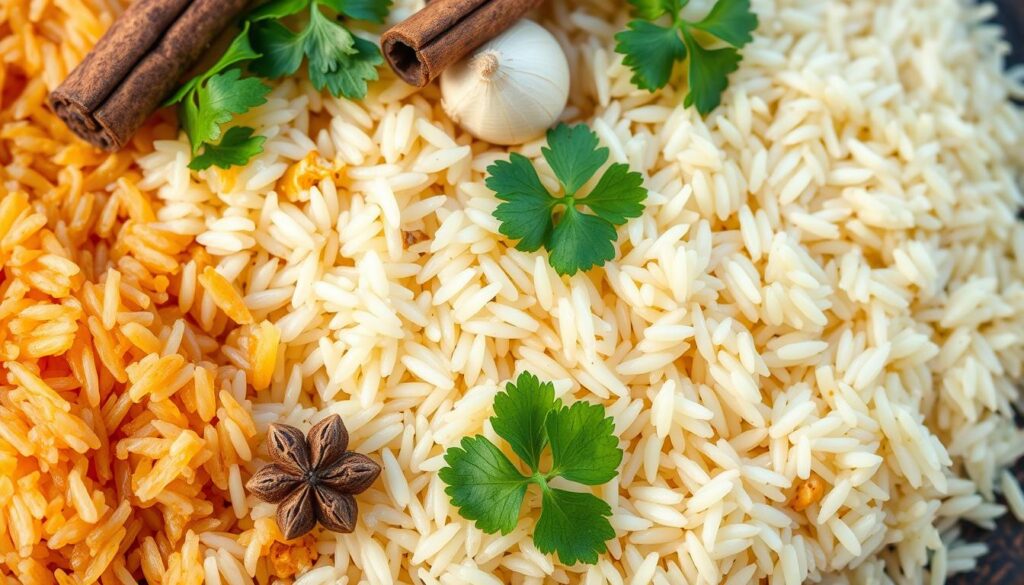
“The perfect rice pilaf is a balance of fluffy rice, aromatic flavors, and rich broth – a truly comforting and satisfying dish.”
Ingredients and their amounts can change based on where you are and your recipe. But the core ingredients stay the same. Knowing these, you can make a delicious and balanced ricepilaf.
Spices and Seasonings
The secret to a great rice pilaf is in its spices and seasonings. Cinnamon and turmeric add warmth and color. Each spice is important for a tasty rice pilaf recipe. Whether you’re making a classic rice pilaf seasoning or trying new rice pilaf variations, knowing your spices is crucial.
Essential Spices for Flavor
At the core of a rice pilaf are special spices. They add depth and complexity. Common spices include:
- Cinnamon: Provides a warm, comforting taste
- Turmeric: Gives a vibrant yellow color and earthy flavor
- Cumin: Adds an aromatic, slightly nutty taste
- Paprika: Brings a sweet touch and subtle heat
Salt and black pepper are must-haves for seasoning. But, some recipes use exotic spice blends like baharat from the Middle East. This creates unique and exciting flavors.
Fresh Herbs and Their Role
Fresh herbs are also key to a traditional rice pilaf recipe. Herbs like parsley, mint, and cilantro add freshness. They complement the spices and bring a refreshing contrast.
The choice of spices and herbs can make a significant difference in flavor. For example, it often varies by region or personal preference. Additionally, this flexibility allows for countless rice pilaf variations and exciting new flavor combinations to explore.
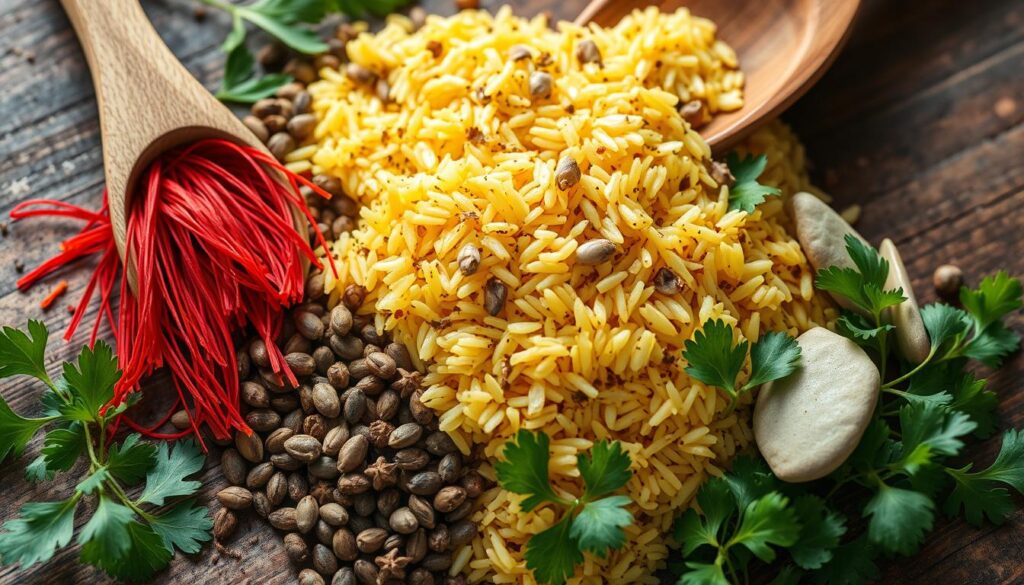
Vegetables Often Included
This meal is a versatile dish that often incorporates a variety of vegetables. For example, peas, chopped carrots, and diced celery are popular choices. Additionally, these vegetables contribute vibrant color, essential vitamins, minerals, and fiber, making the dish both nutritious and visually appealing.
Bell peppers, zucchini, or mushrooms are also common. You can pick vegetables based on what’s in season or what you like. They’re added after the onions to keep their flavors and textures.
Nutritional Benefits of Adding Vegetables to Pilaf
Adding vegetables to this meal not only enhances its flavor but also boosts its nutritional value. Additionally, vegetables are packed with vitamins, minerals, and antioxidants. As a result, they make your meal more balanced and wholesome.
| Vegetable | Key Nutrients | Health Benefits |
|---|---|---|
| Carrots | Vitamin A, Vitamin C, Fiber | Supports eye health, Boosts immune system, Aids digestion |
| Peas | Protein, Fiber, Vitamin K, Vitamin C | Promotes muscle recovery, Supports bone health, Enhances immune function |
| Celery | Vitamin K, Folate, Potassium | Reduces inflammation, Supports heart health, Aids in hydration |
| Bell Peppers | Vitamin C, Vitamin B6, Vitamin E | Boosts immunity, Supports skin health, Enhances cognitive function |
Adding different vegetables to this meal makes it look good and taste great. It also gives you lots of important nutrients. Try different combinations to find what you like best.
Proteins to Enhance Pilaf
Rice pilaf can become a full meal with added protein. You can choose from meats or plant-based options. These choices boost the dish’s flavor and nutrition.
Meats Commonly Used in Pilaf
Chicken, lamb, and ground beef are excellent protein choices for pilaf. For instance, you can cook them separately and then mix them with the rice. Alternatively, cook them together with the pilaf ingredients. Additionally, their flavors blend beautifully with the spices and broth in the rice, enhancing the dish’s overall taste.
Vegetarian Protein Options
For a meatless option, chickpeas or legumes are great. They add creamy texture and nutty taste. Nuts like pistachios or almonds also add crunch and protein. Tofu or tempeh are good plant-based proteins for pilaf.
| Protein Option | Nutrition Facts (per serving) |
|---|---|
| Chicken Pilaf | Calories: 300, Protein: 20g, Fat: 10g, Carbs: 35g |
| Chickpea Pilaf | Calories: 260, Protein: 12g, Fat: 7g, Carbs: 40g |
| Lamb Pilaf | Calories: 325, Protein: 22g, Fat: 15g, Carbs: 30g |
| Tofu Pilaf | Calories: 240, Protein: 15g, Fat: 8g, Carbs: 35g |
Adding proteins to rice pilaf makes it a full meal. Choose from meats or plant-based options. These ingredients make the rice pilaf variations more delicious and healthy.
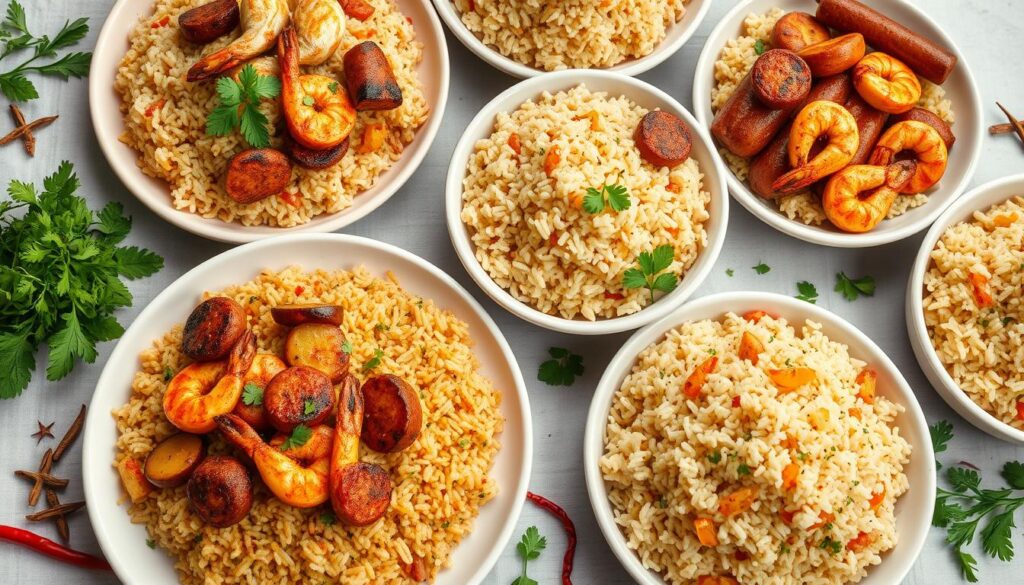
Cooking Methods for Rice Pilaf
There are many ways to make delicious ricepilaf. You can try traditional or modern cooking methods. The classic way is to lightly toast the rice in oil or butter. Then, simmer it in a tasty broth.
This method keeps the rice grains fluffy and full of flavor.
Traditional Cooking Techniques
The traditional pilaf method involves a few steps:
- Sauté aromatic ingredients like onions, garlic, or spices in oil or butter.
- Add the rice and toast it until it’s lightly golden and fragrant.
- Pour in the right amount of broth (like chicken or vegetable) and simmer.
- Cover the pot and cook until the rice is tender and all liquid is absorbed.
- Fluff the pilaf with a fork to keep each grain separate and light.
Modern Methods and Variations
Modern cooks also have their ways of making rice pilaf. You can use a rice cooker or Instant Pot for ease. Some even bake it in the oven for a fluffy texture.
Every method has its own steps. But the basics are the same: brown the aromatics, toast the rice, and let it rest before fluffing. Getting the right liquid-to-rice ratio is key for the perfect texture. With practice, you can make the best rice pilaf recipe and enjoy it as a side dish.
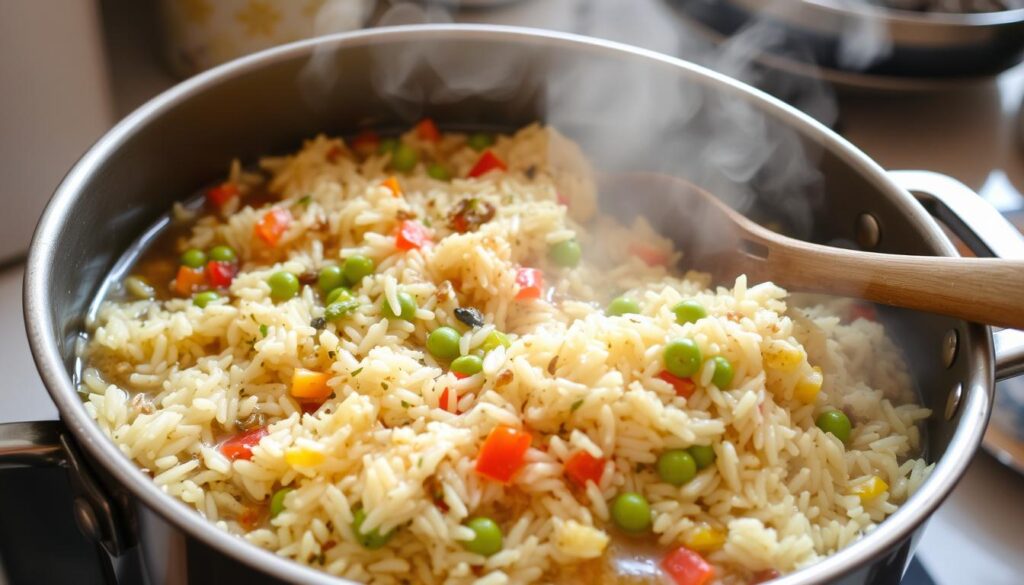
Serving Suggestions for Rice Pilaf
Rice pilaf is a versatile dish that can be paired with many main courses or served as a flavorful base for creative meal ideas. Whether you’re making a traditional rice pilaf recipe or trying out this meal variations, there are countless ways to enjoy it.
Pairing with Main Dishes
This meal pairs wonderfully with grilled, roasted, or braised proteins. For example, serve it with grilled chicken, roasted vegetables, or hearty stews for a balanced meal. Additionally, the pilaf’s mild, savory flavors complement a variety of main dishes, making it a versatile side.
Creative Serving Ideas
- Use pilaf as a stuffing for baked bell peppers, tomatoes, or zucchini for a visually appealing and flavorful presentation.
- Incorporate pilaf into salads for added texture and heartiness.
- Top the pilaf with toasted nuts, dried fruits, or fresh herbs for a flavor and textural boost.
- Mold the pilaf into shapes, such as patties or cakes, for an elegant serving style.
- Serve the pilaf family-style in a large bowl, allowing guests to scoop and enjoy it as a side dish.
Regardless of how you choose to serve it, this meal is a versatile and delicious option that can elevate any meal. Experiment with different recipes and variations to find your new favorite way to enjoy this classic dish.
Nutritional Aspects of Rice Pilaf
Rice pilaf is a tasty dish that’s also good for you. It has about 287 calories per serving. This comes from 45% carbs, 48% fat, and 7% protein. It’s a satisfying dish with 173 calories per 100 grams.
Caloric Breakdown and Health Benefits
One serving of rice pilaf has 31 grams of carbs, 7 grams of saturated fat, 1 gram of fiber, and 0.3 grams of sugar. It’s good for energy and digestion. It also has lots of vitamins and minerals like iron, folate, copper, manganese, and thiamine.
Dietary Considerations and Modifications
If you’re gluten-free, make sure all ingredients are gluten-free. You can make low-sodium rice pilaf by using less salt. Try using brown rice for more fiber and nutrients. Just remember, brown rice takes longer to cook.
Related to Is Rice Pilaf Gluten Free? Discover the Facts!
FAQ
What is rice pilaf made of?
Rice pilaf is a tasty rice dish cooked in broth with spices. It includes long-grain rice, oil or butter, and onions. Garlic, chicken or vegetable broth, and seasonings like salt and pepper are also key. You can add vegetables, meats, or dried fruits too.
What is the definition of rice pilaf?
Rice pilaf is a cooking method, not a specific rice type. It starts with browning rice in oil or butter with aromatics. Then, it’s cooked in stock. This method is loved worldwide, found in many cuisines.
What types of rice are suitable for pilaf?
Long-grain white rice, like basmati, is best for pilaf because it’s fluffy. Brown rice works too, but it takes longer to cook and needs more liquid.
What are the common aromatics used in rice pilaf?
Onions and garlic are common aromatics in pilaf. Chicken or vegetable broth adds rich flavor to the dish.
What are the essential spices and seasonings for rice pilaf?
Essential ingredients include olive oil or butter, salt, and pepper. Spices like cinnamon, turmeric, cumin, and paprika are also common. Fresh herbs like parsley, mint, or cilantro add brightness and flavor.
What vegetables are commonly included in rice pilaf?
Peas, chopped carrots, and diced celery are common in pilaf. They add color, texture, and nutrients.
What protein sources can be added to rice pilaf?
You can add meats like chicken, lamb, or ground beef for a heartier dish. For vegetarians, chickpeas or other legumes are great options.
What are the traditional and modern cooking methods for rice pilaf?
Traditional pilaf starts with toasting rice in oil or butter, then simmering in broth. Modern methods include using a rice cooker or Instant Pot for ease. Baking pilaf in the oven is another option.
How can rice pilaf be served and paired with other dishes?
Rice pilaf goes well with grilled meats, roasted vegetables, or stews. It’s great as a side dish or a base for bowl meals. You can also use pilaf as a stuffing for vegetables or in salads.
What are the nutritional aspects and dietary considerations for rice pilaf?
Rice pilaf offers carbs, some protein, and important vitamins and minerals. A serving has about 250 calories. For gluten-free diets, make sure all ingredients, including broths, are gluten-free. Brown rice can boost fiber and nutrients compared to white rice.





